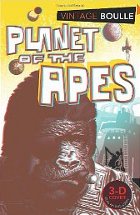Planet of the apes by Pierre Boulle

Vintage, 2011 (originally published 1963). ISBN 9780099529040.
(Age 15+) Ulysse Merou is a journalist who accompanies the brilliant scientist
Professor Antille on an inter-galactic journey to a planet called
Soror. Conveniently but necessarily this new world has an atmosphere
and environment which is almost identical to Earth's. The travellers
attain a speed near that of light, enabling both the passage of
unimaginable distances and the crossing of hundreds of years in
comparative time.
Merou and his party naturally seek contact when they discover the
planet's humanoid population. The reader learns that the humans are
completely backward, with no obvious intellectual capacity, verbal
communication or understanding of objects such as tools or even
clothing. Whilst this tentative encounter is taking place, a highly
organised operation to drive the people from the forest is
undertaken by gorillas who enjoy shooting them for sport but who are
also charged with collecting specimens for scientific research. The
reader comprehends that Soror is controlled by gorillas, orangutans
and chimpanzees who are intellectually and technologically
developed.
The continuing narrative focuses on Merou as he struggles to survive
captivity as a scientific subject and the story gains significant
momentum and depth as he demonstrates his superior cerebral capacity
to the chimpanzee researchers.
This story is compelling and enjoyable but its most valuable feature
is a marvellous philosophical examination of the treatment and abuse
of other species for science. It was curious to feel indignant and
even appalled at the treatment of humans by monkeys who are cast as
unfeeling and even cruel, but then be reminded that this is merely a
mirror of our own attitudes towards 'lesser species'.
The academic consideration of the evolution of apes against the
regression of man and a thought provoking analysis of learning
versus imitation is a strong theme within the tale. So engaging are
the philosophical aspects of the story that the reader is forgiving
of some very clumsy science fiction constructs and a flimsy literary
framework which allows the tale to be introduced and concluded.
Published in 1963, this novel possibly compares poorly against
modern science fiction which has benefited from five decades of
staggering technological development. Together with true science,
today's authors may also draw upon a wealth of science fiction
imagination which has gone before.
This is still a wonderful book however and readers 15 and older will
cope with the complexities posed by the theme and peculiarities from
translation.
Rob Welsh